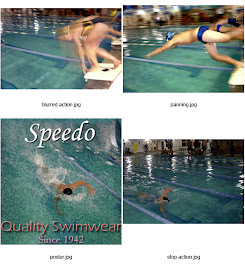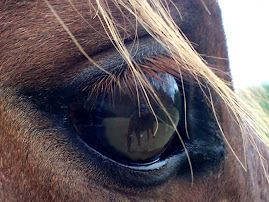We will be going outside today to begin the following project. You should take any missing photos over the weekend. This project is due, in full, on Monday, November 5th. As we move along in our composition unit, you will get a test that is very much like this project. It would be a good idea to practice taking all 20 shots, even though only 12 are required on your contact sheet. You'll have time on Monday to prepare the word document. You'll get a handout today. Here are the instructions:
We have studied various elements of design and techniques for achieving good photographic composition. Your assignment is to take a number of photographs that illustrate the following:
· Proper use of the Rule of Thirds
· Good choice of background to accentuate subject
· Depth of field used to accentuate the subject (selective focus)
· Perspective lines used to create depth
· Demonstration of scale
· Framing with objects in foreground
· Unusual point of view to create interest
· Dynamic composition with proper use of diagonals
· Emphasis on texture
· Use of repetition (either color, shape, or line)
· Good use of negative space
· Asymmetrical balance
· Positioning action moving into frame
We have also discussed design mistakes that should be avoided. Take photos that illustrate what NOT to do:
· Merging
· Poor choice of background
· Subject moving or looking out of frame
· Undesirable cut-off
· Centered composition (boring, static)
· Lens flare
· Lack of simplicity where subject is not clearly defined
Download the photos and make a contact sheet showing 12 different topics outlined above. Do not edit in PhotoShop! Use them just as they came out of camera. Title each photo to indicate what you are illustrating. Select the six that you feel best illustrate six different topics. Copy and paste to a Word document with a paragraph about each photo. You should describe how each photo depicts good composition through the proper use of these techniques or poor composition because of design mistakes.
skip to main |
skip to sidebar

by Barry Lawler

by anonymous 2008 student

Student work 2006-07

from DeviantArt

student work

by Melissa McDonald

by Alyssa Gill

by Adam Preiser

by Cody Stone

by Zac Coyle

by Melanie Broadhurst

from the Internet

By Elke Talbot
.jpg)
By Eric Crostic

By Caroline Zarate

Student Work 06-07

Student Work 2006-07

by Zac Coyle

"We've been Hockneyized!!"

Created by Ms. Finch

student work-- 2nd period 2007

Student Work 2006-07

Student Work 2006-7

created by Ms.Finch in class

created by Ms. Finch in class

Student work 06-07







Selective Focus

full focus


(student work)

Art Show Winner!!

by Barry Lawler
sample "Liquified Face"

by anonymous 2008 student
Beach Duotone

Student work 2006-07
sample 'Song Lyrics Project'

from DeviantArt
sample of 'locational' picture

student work
Sample Line Art

by Melissa McDonald
FREESTYLE!

by Alyssa Gill
FREESTYLE!

by Adam Preiser
FREESTYLE!

by Cody Stone
FREESTYLE!

by Zac Coyle
Sample Final Project (4 images)

by Melanie Broadhurst
Action Photo with Text (Poster)

from the Internet
Sample Animal Photos:

By Elke Talbot
.jpg)
By Eric Crostic
Sample Montage

By Caroline Zarate
sample Metaphor Self-Portrait

Student Work 06-07
Sample Still Life

Student Work 2006-07
A Winner from Last Year's Art Show:

by Zac Coyle

"We've been Hockneyized!!"
Sample Catalog Page

Created by Ms. Finch
Sample Backlit with and w/o flash

student work-- 2nd period 2007
Portrait Collage

Student Work 2006-07
Sample Before and After

Student Work 2006-7
Sample Collage

created by Ms.Finch in class
Sample Collage

created by Ms. Finch in class
Interesting Macro Sample

Student work 06-07
landscape photography (student work)

Macro Photography

ANSEL ADAMS

Black and White Student Choice

06-07 Student Work

B&W Examples

Examples of Nature Shots

Selective Focus
Examples of Nature Shots

full focus
"Rock Star Day"

Examples of "BOLD, COLORFUL"

(student work)
Blog Archive
-
▼
2007
(43)
-
▼
November
(17)
- NHIs
- Last chance for 5 extra credit points on your next...
- weekend assignment
- What is CRITIQUE????
- Help with Compostion
- Test on Composition
- Collages/Thanksgiving assignment
- Photography Contest
- Macro--second chance!
- Short day Friday
- Next Photo Shoot...
- Thank You cards for Vets
- Landscape/Seascape
- Research Paper on Composition
- Perspective vs.Point of View
- Next Photo Assignment
- "Theories of Composition" photo shoot
-
▼
November
(17)
About Me

- LISA JOHNSON FINCH
- I am an artist living on the NC Outer Banks(OBX). I hold degrees in both Commercial Art and Fine Arts. I am a painter, photographer, and graphic designer. I am inspired by the natural beauty I see on these barrier islands every day, and try to capture that feeling of tranquility on canvas. As much as I appreciate OBX scenery, my favorite subject matter is portraiture--- particularly babies and children. I enjoy depicting pregnancy and breastfeeding. I love capturing that unique mother/child bond. I have a few pieces displayed in local businesses and galleries. However, I can offer a substantial savings when I am able to cut out the middleman, so to speak, by selling and shipping directly. I also accept work by commission. Send me photos of your kids, pets, or house, and I can create a personal painting just for you or a loved one! How about a fantasy piece? Turn the little girl in your life into a mermaid; your young man into a little surfer dude! Samples of my work are online and you may contact me through Facebook or my email address with any questions. obxlisafinch@embarqmail.com
